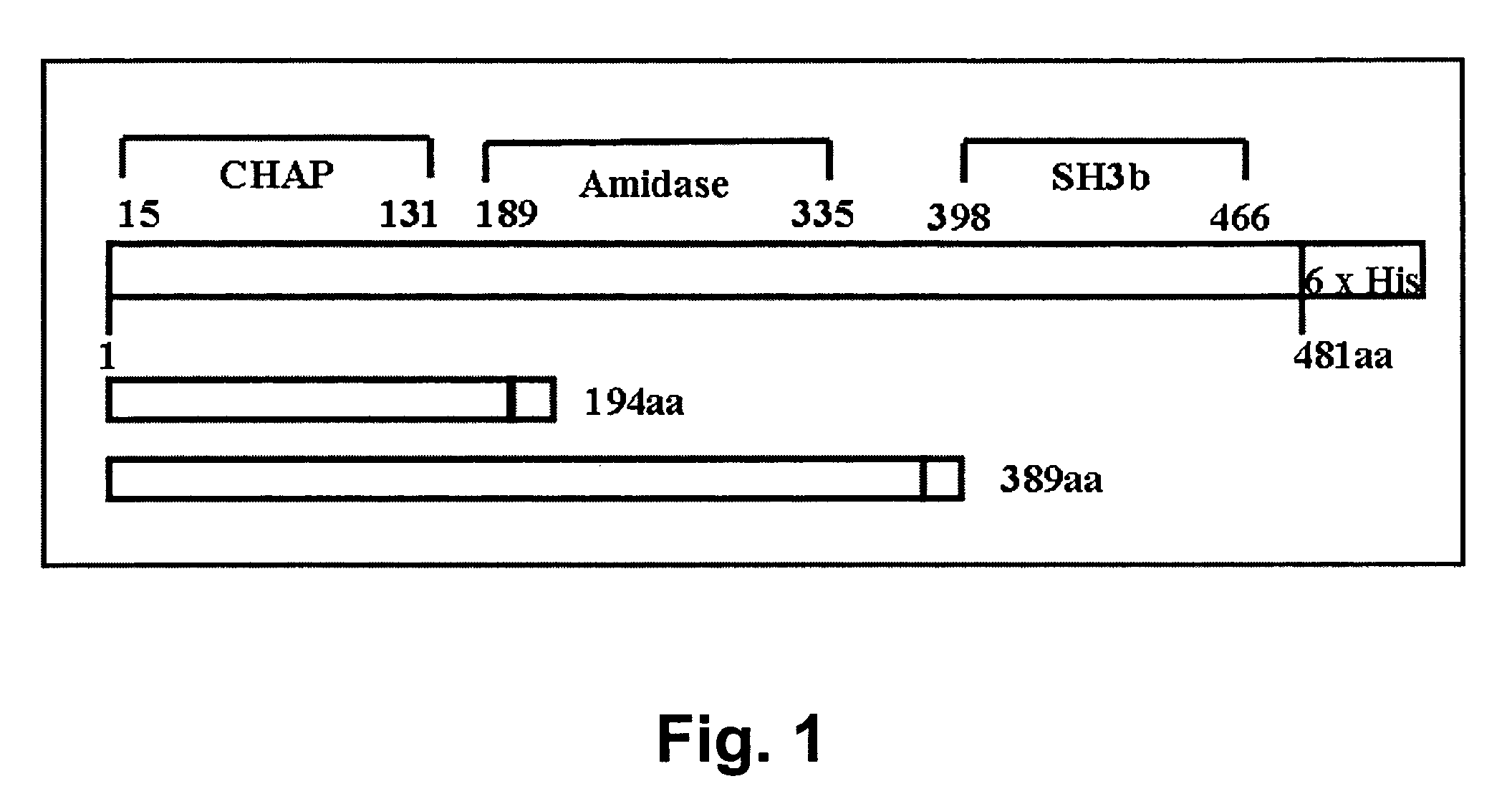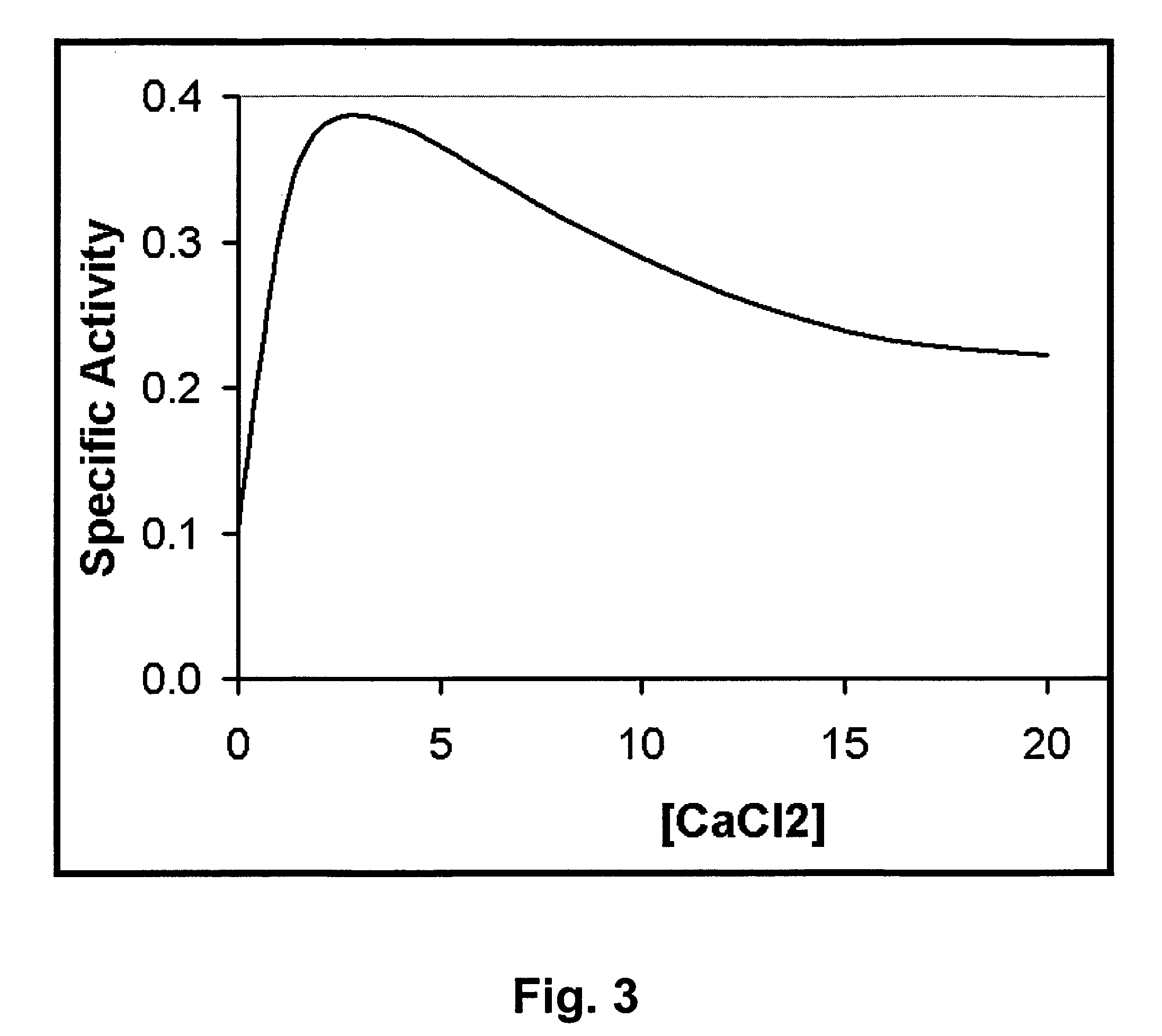Specific lysis of staphylococcal pathogens by bacteriophage phi11 endolysin
a technology of endolysin and bacteriophage phi11, which is applied in the field of nucleic acid, can solve the problems of premature culling, less than 50% effective, and costing two billion dollars annually
- Summary
- Abstract
- Description
- Claims
- Application Information
AI Technical Summary
Benefits of technology
Problems solved by technology
Method used
Image
Examples
example 1
Bacterial Strains and Culture Conditions
[0074]Cloning and vector constructs were maintained in E. coli DH5α cells (Invitrogen, Carlsbad, Calif.) or E. coli BL21 (DE3) cells (EMD Biosciences, San Diego, Calif.). Staphylococcus aureus (ATCC 29740) and the mastitis isolates Streptococcus agalactiae, S. chronogenes, S. epidermis, S. hyicus, S. simulans, S. warneri, and S. xylocus (USDA) were grown at 37° C. in Brain Heart Infusion (DIFCO, Franklin Lakes, N.J.).
example 2
[0075]The AmpR plasmid pTZ18R contains the phi11 endolysin on a 3 kb EcoRI fragment of the phi11 bacteriophage genome (gift from R. Jayaswal; Jayaswal et al. 1990. J. Bacteriol. 172: 5783-5788). The endolysin gene was subcloned into pET21a (EMD Biosciences, San Diego, Calif.) via PCR of pTZ18R plasmid template. High fidelity PCR (Deep Vent Polymerase; New England Biolabs, Ipswich, Mass.) with primers that introduce unique restriction enzyme (RE) sites NdeI (CATATG, includes an ATG translation initiation site), and XhoI (at the translational stop sequence, amino acid 481) were used to amplify the full length phi11 endolysin coding sequences (phi11-481). Two primers, each with the following sequences: forward primer LytA NdeI, 5′-GTG GCG CAT ATG CAA GCA AAA TTA AC-3′ (SEQ ID NO:7) and reverse primer LytA Xho1481 5′-T GAC TAT GTC CTC GAG ACT GAT TTC-3′ (SEQ ID NO:8) were used for amplification; introduced RE sites are underlined. These sites were designed to allow subcloning...
example 3
Extract Preparation and Protein Purification
[0079]E. coli BL21(DE3) cells harboring plasmid constructs were grown in 500 ml Superbroth (Becton Dickenson, Franklin Lakes, N.J.) supplemented with 100 ug / ml ampicillin at 37° C. with shaking. At mid log phase (OD600nm of 0.4-0.6), cultures were induced with 1 mM IPTG (isopropyl-beta-D-thiogalactopyranoside) followed by four hours shaking at 37° C. Cells were pelleted, washed with lysis buffer (50 mM NaH2PO4, 300 mM NaCl, 10 mM Imidazole, pH 8) and pellets frozen at −80° C. Extracts were prepared according to a modified procedure of Pritchard et al. (2004. Microbiology 150: 2079-2087). For nickel column-purified protein, cell pellets from 500 ml cultures were resuspended in 10 ml lysis buffer (50 mM NaH2PO4, 300 mM NaCl, 10 mM Imidazole, pH 8) and disrupted with 15×10 second pulses of sonication on ice with 10 second rest periods between pulses. Lysates were centrifuged at 6800 rpm in a Sorvall HS4 rotor (8500×g) and the supernatant deca...
PUM
| Property | Measurement | Unit |
|---|---|---|
| Tm | aaaaa | aaaaa |
| temperatures | aaaaa | aaaaa |
| pH | aaaaa | aaaaa |
Abstract
Description
Claims
Application Information
 Login to View More
Login to View More - R&D
- Intellectual Property
- Life Sciences
- Materials
- Tech Scout
- Unparalleled Data Quality
- Higher Quality Content
- 60% Fewer Hallucinations
Browse by: Latest US Patents, China's latest patents, Technical Efficacy Thesaurus, Application Domain, Technology Topic, Popular Technical Reports.
© 2025 PatSnap. All rights reserved.Legal|Privacy policy|Modern Slavery Act Transparency Statement|Sitemap|About US| Contact US: help@patsnap.com



